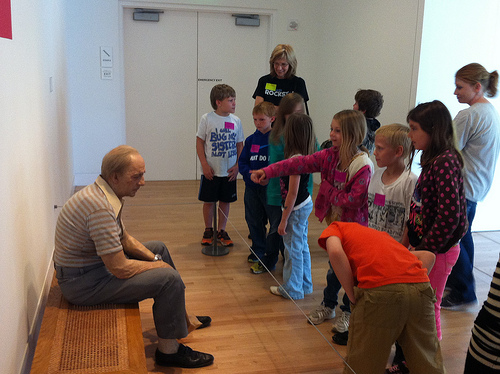While seated in a gallery reflection area during her break, Museum Security Patrol Officer Janet overheard a somewhat panicked voice. “Sir,” the voice inquired. “Sir, are you okay?” Janet turned around to observe a woman, bent at the waist, looking down at Duane Hanson’s sculpture Man on Bench with concern.
Man on Bench, a favorite among Museum guests, never fails to evoke a response.
“People will ask if he is real,” shared Gallery Attendant Stacy. “They’ll ask, ‘Is he an actor? Is he going to jump out at us?’”
Patrol Officer Charles has also witnessed Museum-goers chatting with the sculpture. Eventually, they notice the stanchions surrounding the work or the artwork label, and the conversation ends.
Duane Hanson (1925-1996) is best known for these hyper-realistic sculptures. Hanson began producing direct-cast sculptures of human figures in 1966, and he so enjoyed working with the human form that it became his sole artistic focus for the remainder of his career. He spent the next three decades refining his process, taking the greatest care to eliminate any indication that his replicas were anything but human. He replaced wigs with fake strands of hair; he developed techniques to eliminate the appearance of tool marks.

Process images from Marco Livingstone’s 1997 book “Duane Hanson” (Available in the Crystal Bridges Library)
Hanson wanted to fool his audience, but more than that, he wanted to make them feel something. Looking beyond the convincing textures, his figures also depict lifelike postures and what appear to be genuine emotions.
Katherine Plake Hough, Director of Collections and Exhibitions at the Palm Springs Desert Museum, described Hanson’s work as a balance between brutal honesty and compelling tenderness. Man on Bench is the perfect example of this intersection between honesty and tenderness. While it’s not a flattering depiction of the model, it invites the viewer to connect with the man. The subtle emotion communicated through his posture and facial expression seems incredibly authentic; he appears to be sincerely despondent. The effectiveness of this deceptive portrayal of human sentiment is made evident by the numerous people who have tried to console him. Hanson’s attention to detail is so compelling that he’s managed to elicit genuine empathy from his audience.
So, in response to the question that everyone to asks, “Are you okay?” … he’s fine. He might be a little sore after 37 years on the same bench, but the people-watching is great!






